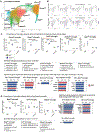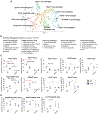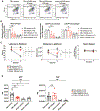CCR2 deficiency alters activation of microglia subsets in traumatic brain injury
- PMID: 34551293
- PMCID: PMC8594931
- DOI: 10.1016/j.celrep.2021.109727
CCR2 deficiency alters activation of microglia subsets in traumatic brain injury
Abstract
In traumatic brain injury (TBI), a diversity of brain resident and peripherally derived myeloid cells have the potential to worsen damage and/or to assist in healing. We define the heterogeneity of microglia and macrophage phenotypes during TBI in wild-type (WT) mice and Ccr2-/- mice, which lack macrophage influx following TBI and are resistant to brain damage. We use unbiased single-cell RNA sequencing methods to uncover 25 microglia, monocyte/macrophage, and dendritic cell subsets in acute TBI and normal brains. We find alterations in transcriptional profiles of microglia subsets in Ccr2-/- TBI mice compared to WT TBI mice indicating that infiltrating monocytes/macrophages influence microglia activation to promote a type I IFN response. Preclinical pharmacological blockade of hCCR2 after injury reduces expression of IFN-responsive gene, Irf7, and improves outcomes. These data extend our understanding of myeloid cell diversity and crosstalk in brain trauma and identify therapeutic targets in myeloid subsets.
Keywords: CCR2; dendritic cells; innate immunity; macrophages; microglia; monocytes; neuroinflammation; single-cell RNA sequencing; traumatic brain injury; type I IFN.
Published by Elsevier Inc.
Conflict of interest statement
Declaration of interests I.C., B.A.Z., J.C., and R.S. are presently or were employees of ChemoCentryx during this study. B.T.W., S.G., L.J., M.C., G.B., and E.D.P. are presently or were employees of Biogen during this study. B.T.W. is currently employed by Moderna. C.J.Y. is a Scientific Advisory Board member for and hold equity in Related Sciences and ImmunAI, a consultant for and hold equity in Maze Therapeutics, and a consultant for TReX Bio. C.J.Y. has received research support from Chan Zuckerberg Initiative, Chan Zuckerberg Biohub, and Genentech. A U.S. Provisional Patent Application No. 63/177,727 for the use of CCX872 in TBI, spinal cord injury, or stroke was filed April 21, 2021.
Figures






References
-
- Boring L, Gosling J, Cleary M, and Charo IF (1998). Decreased lesion formation in CCR2−/− mice reveals a role for chemokines in the initiation of atherosclerosis. Nature 394, 894–897. - PubMed
-
- Buttgereit A, Lelios I, Yu X, Vrohlings M, Krakoski NR, Gautier EL, Nishinakamura R, Becher B, and Greter M (2016). Sall1 is a transcriptional regulator defining microglia identity and function. Nat. Immunol 17, 1397–1406. - PubMed
Publication types
MeSH terms
Substances
Grants and funding
LinkOut - more resources
Full Text Sources
Medical
Molecular Biology Databases

